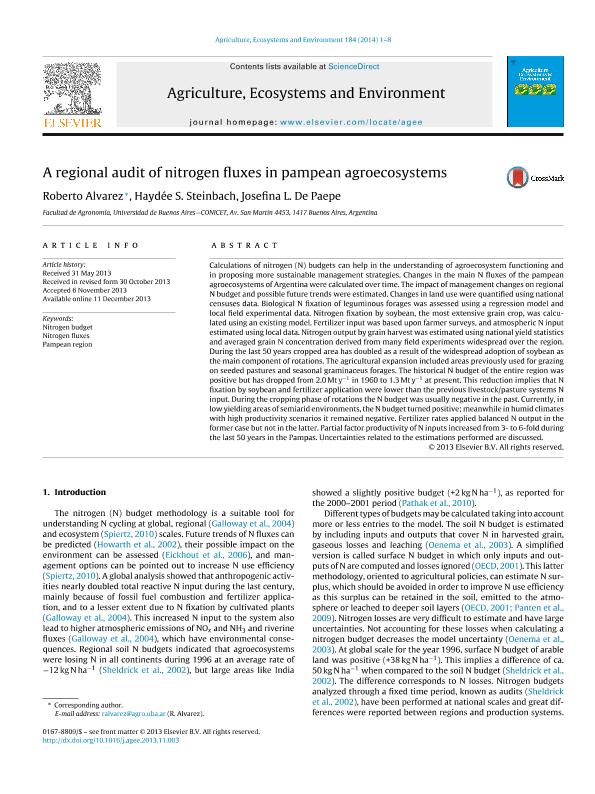Mostrar el registro sencillo del ítem
dc.contributor.author
Alvarez, Roberto

dc.contributor.author
Steinbach, Haydée
dc.contributor.author
de Paepe, Josefina

dc.date.available
2017-04-25T15:26:30Z
dc.date.issued
2014-01
dc.identifier.citation
Alvarez, Roberto; Steinbach, Haydée; de Paepe, Josefina; A regional audit of nitrogen fluxes in pampean agroecosystems; Elsevier; Agriculture, Ecosystems And Environment; 184; 1-2014; 1-8
dc.identifier.issn
0167-8809
dc.identifier.uri
http://hdl.handle.net/11336/15706
dc.description.abstract
Calculations of nitrogen (N) budgets can help in the understanding of agroecosystem functioning and in proposing more sustainable management strategies. Changes in the main N fluxes of the pampean agroecosystems of Argentina were calculated over time. The impact of management changes on regional N budget and possible future trends were estimated. Changes in land use were quantified using national censuses data. Biological N fixation of leguminous forages was assessed using a regression model and local field experimental data. Nitrogen fixation by soybean, the most extensive grain crop, was calculated using an existing model. Fertilizer input was based upon farmer surveys, and atmospheric N input estimated using local data. Nitrogen output by grain harvest was estimated using national yield statistics and averaged grain N concentration derived from many field experiments widespread over the region. During the last 50 years cropped area has doubled as a result of the widespread adoption of soybean as the main component of rotations. The agricultural expansion included areas previously used for grazing on seeded pastures and seasonal graminaceus forages. The historical N budget of the entire region was positive but has dropped from 2.0 Mt y−1 in 1960 to 1.3 Mt y−1 at present. This reduction implies that N fixation by soybean and fertilizer application were lower than the previous livestock/pasture systems N input. During the cropping phase of rotations the N budget was usually negative in the past. Currently, in low yielding areas of semiarid environments, the N budget turned positive; meanwhile in humid climates with high productivity scenarios it remained negative. Fertilizer rates applied balanced N output in the former case but not in the latter. Partial factor productivity of N inputs increased from 3- to 6-fold during the last 50 years in the Pampas. Uncertainties related to the estimations performed are discussed.
dc.format
application/pdf
dc.language.iso
eng
dc.publisher
Elsevier

dc.rights
info:eu-repo/semantics/openAccess
dc.rights.uri
https://creativecommons.org/licenses/by-nc-nd/2.5/ar/
dc.subject
Balance de Nitrógeno
dc.subject
Fijación de Nitrógeno
dc.subject
Productividad Parcial
dc.subject
Región Pampeana
dc.subject.classification
Agricultura

dc.subject.classification
Agricultura, Silvicultura y Pesca

dc.subject.classification
CIENCIAS AGRÍCOLAS

dc.title
A regional audit of nitrogen fluxes in pampean agroecosystems
dc.type
info:eu-repo/semantics/article
dc.type
info:ar-repo/semantics/artículo
dc.type
info:eu-repo/semantics/publishedVersion
dc.date.updated
2017-04-25T13:28:04Z
dc.journal.volume
184
dc.journal.pagination
1-8
dc.journal.pais
Países Bajos

dc.journal.ciudad
Amsterdam
dc.description.fil
Fil: Alvarez, Roberto. Universidad de Buenos Aires. Facultad de Agronomia; Argentina. Consejo Nacional de Investigaciones Científicas y Técnicas. Oficina de Coordinación Administrativa Parque Centenario; Argentina
dc.description.fil
Fil: Steinbach, Haydée. Universidad de Buenos Aires. Facultad de Agronomia; Argentina
dc.description.fil
Fil: de Paepe, Josefina. Universidad de Buenos Aires. Facultad de Agronomia; Argentina. Consejo Nacional de Investigaciones Científicas y Técnicas. Oficina de Coordinación Administrativa Parque Centenario; Argentina
dc.journal.title
Agriculture, Ecosystems And Environment

dc.relation.alternativeid
info:eu-repo/semantics/altIdentifier/url/http://www.sciencedirect.com/science/article/pii/S0167880913003873
dc.relation.alternativeid
info:eu-repo/semantics/altIdentifier/doi/http://dx.doi.org/10.1016/j.agee.2013.11.003
Archivos asociados
